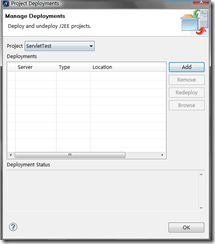MyEclipse+Jboss+HSQL开发Servlet服务器
一.工具软件名称:
MyEclipse 8.0 +jboss-4.0.5.G
二.准备工作:
解压jboss,然后设置系统Path,%JBOSS_HOME%/bin;
三.在MyEclipse8里配置JBOSS服务器
在MyEclipse8下的Window-->Preferences下的Servers找到JBoss下的JBoss4.x
点OK后 这个小三角下就有一个JBOSS4.X,点Start运行服务器。
这个小三角下就有一个JBOSS4.X,点Start运行服务器。
四.使用Hypersonic 数据库创建一个表格的具体步骤:
步骤一:测试JBoss服务器是否正常运行,在IE浏览器中输入网址:http://127.0.0.1:8080/jmx-console/
步骤二:在该网页中查找一个叫做“jboss”子标题,其下有个超级链接,该超级链接文字是
“database=localDB,service=Hypersonic”
步骤三:在该页面中有一个叫做“startDatabaseManager”的MBean 操作,在它的右边有个“Invoke”
步骤四:点击“Invoke”按钮则会弹出一个名为“HSQL Database Manager”的数据库管理程序。左边列举了目前数据库中已经存在的表格和数据库的名称,右边是一个用于输入SQL语句的文本框和一个显示结果的文本框。
步骤五:在“HSQL Database Manager”的数据库管理程序中创建两个表格(用于“联网心理测试”),
其中表格“STOREANSWER”包括3个字段:用户,ID,用户姓名和测试答案,这个表格存储客户端的一些基本信息和测试答案。
表格“IQQUESTION” 包括3个字段:问题序号,问题内容,问题的标题答案,这个表格负责提供测试的题目和标准答案,
创建表格的代码如下:
CREATE TABLE STOREANSWER (USERID VARCHAR(6) NOT NULL PRIMARY KEY,USERNAME VARCHAR(15),ANSWER VARCHAR(30))
CREATE TABLE IQQUESTION (ANSEWRID VARCHAR(6) NOT NULL PRIMARY KEY,QUESTION VARCHAR(500),ANSWER VARCHAR(2))
在工具栏单击“Execute SQL Statement”
步骤六:在表格“IQQUESTION”中填入一些测试数据,代码如下:
INSERT INTO IQQUESTION (ANSWERID , QUESTION , ANSWER) VALUES ('Q1','Question1','A')
INSERT INTO IQQUESTION (ANSWERID , QUESTION , ANSWER) VALUES ('Q2','Question2','B')
INSERT INTO IQQUESTION (ANSWERID , QUESTION , ANSWER) VALUES ('Q3','Question3','C')
INSERT INTO IQQUESTION (ANSWERID , QUESTION , ANSWER) VALUES ('Q4','Question4','D')
INSERT INTO IQQUESTION (ANSWERID , QUESTION , ANSWER) VALUES ('Q5','Question5','A')
INSERT INTO IQQUESTION (ANSWERID , QUESTION , ANSWER) VALUES ('Q6','Question6','B')
在工具栏单击“Execute SQL Statement”
步骤七:在右边输入查询语句,SELECT * FROM IQQUESTION,在工具栏单击“Execute SQL Statement”
五:编写测试程序Servlet
步骤一:在MyEclipse8下创建HttpServlet,file—>new—>Web Project 建个工程名为ServletTest,
步骤二:在此工程下新建一个Servlet,命名为NetWorkTest ,在file—>new—>MyEclipse—>web—>Servlet
代码如下:
package com.test;
import java.io.IOException;
import java.io.PrintWriter;
import java.sql.Connection;
import java.sql.PreparedStatement;
import java.sql.ResultSet;
import javax.naming.InitialContext;
import javax.servlet.ServletConfig;
import javax.servlet.ServletException;
import javax.servlet.http.HttpServlet;
import javax.servlet.http.HttpServletRequest;
import javax.servlet.http.HttpServletResponse;
import javax.sql.DataSource;
public class NetWorkTest extends HttpServlet {
/**
*
*/
private static final long serialVersionUID = 1L;
// 连接池名称
protected static final String DBName = "java:DefaultDS";
private DataSource dataSource;
private String question;
public void init(ServletConfig config) throws ServletException {
try {
// 初始化连接池
InitialContext ic = new InitialContext();
dataSource = (DataSource) ic.lookup(DBName);
} catch (Exception e) {
e.printStackTrace();
throw new ServletException("init error");
}
}
/**
* Constructor of the object.
*/
public NetWorkTest() {
super();
}
/**
* Destruction of the servlet.
*/
public void destroy() {
super.destroy(); // Just puts "destroy" string in log
// Put your code here
}
/**
* The doGet method of the servlet.
*
* This method is called when a form has its tag value method equals to get.
*
* @param request
* the request send by the client to the server
* @param response
* the response send by the server to the client
* @throws ServletException
* if an error occurred
* @throws IOException
* if an error occurred
*/
protected void doGet(HttpServletRequest request,
HttpServletResponse response) throws ServletException, IOException {
String userid = null;
Connection c;
try {
c = dataSource.getConnection();
// 执行查询语句
PreparedStatement ps = c.prepareStatement("SELECT *"
+ " FROM IQQUESTION");
ResultSet rs = ps.executeQuery();
PrintWriter out = response.getWriter();
while (rs.next()) {
// 获得表格第一个字段的数据
question = rs.getString(2);
response.setContentType("text/plain");
// 显示到屏幕上
out.print(this.getServletInfo() + "/n");
out.print("QUESTION:" + question + "/n");
out.print("
");
}
// out.flush();
out.close();
rs.close();
ps.close();
c.close();
} catch (Exception e) {
e.printStackTrace();
}
// response.setContentType("text/html");
// PrintWriter out = response.getWriter();
// out
// .println("");
// out.println("");
// out.println(" A Servlet");
// out.println(" ");
// out.print(" This is ");
// out.print(this.getClass());
// out.println(", using the GET method");
// out.println(" ");
// out.println("");
}
/**
* The doPost method of the servlet.
*
* This method is called when a form has its tag value method equals to
* post.
*
* @param request
* the request send by the client to the server
* @param response
* the response send by the server to the client
* @throws ServletException
* if an error occurred
* @throws IOException
* if an error occurred
*/
protected void doPost(HttpServletRequest request,
HttpServletResponse response) throws ServletException, IOException {
doGet(request, response);
// response.setContentType("text/html");
// PrintWriter out = response.getWriter();
// out
// .println("");
// out.println("");
// out.println(" A Servlet");
// out.println(" ");
// out.print(" This is ");
// out.print(this.getClass());
// out.println(", using the POST method");
// out.println(" ");
// out.println("");
// out.flush();
// out.close();
}
}
步骤三:在web.xml中输入发布Servlet必须信息。
代码如下:
1: <servlet>
2: <description>This is the description of my J2EE component description>
3: <display-name>This is the display name of my J2EE component display-name>
4: <servlet-name>NetWorkTest servlet-name>
5: <servlet-class>com.test.NetWorkTest servlet-class>
6: servlet>
7:
8: <servlet-mapping>
9: <servlet-name>NetWorkTest servlet-name>
10: <url-pattern>/NetWorkTest url-pattern>
11: servlet-mapping>
注意:第5,10行一定要和上面的一样。com.test是包名
步骤四:发布Servlet,点MyEclipse里 发布按钮,
 在这个窗口里选要发布的项目名,ServletTest,在点add,找到jboss服务器,
在这个窗口里选要发布的项目名,ServletTest,在点add,找到jboss服务器,![]() 一路OK后。就发布完了。
一路OK后。就发布完了。
步骤五:启动JBOSS jboss –>start
六:在IE浏览器上访问Servlet
在IE浏览器上输入http://127.0.0.1:8080/ServletTest/NetWorkTest
七:这时你的服务器就配置完了。

